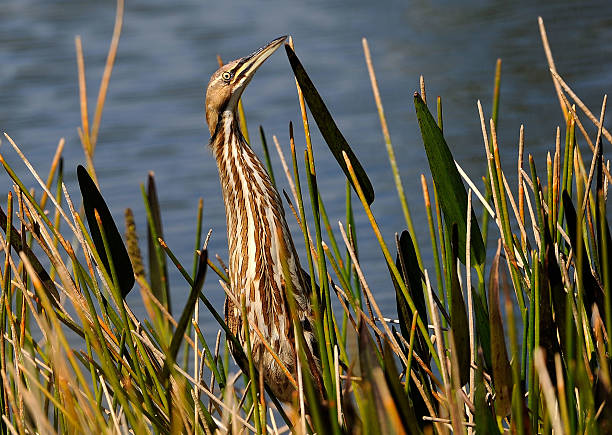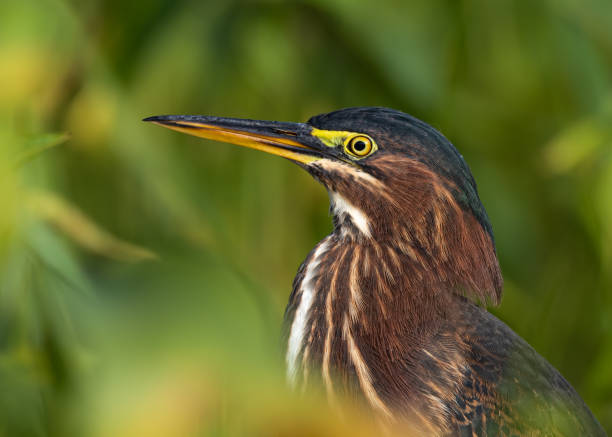Table of Contents
Scientific Classification
| Rank Classification Kingdom | Animalia |
| Phylum | Chordata |
| Class | Aves |
| Order | Pelecaniformes |
| Family | Ardeidae |
| Genus | Botaurus |
| Species | Botaurus lentiginosus |
| Scientific Name | Botaurus lentiginosus |
Description
The American Bittern (Botaurus lentiginosus) is a medium-sized wading bird known for its remarkable ability to camouflage itself in its environment. With its brown and tan streaked feathers, it blends seamlessly into the reeds and marsh vegetation. This bird has a robust body and a long, pointed bill, while its yellowish legs are well-suited for wading in shallow waters. The American Bittern can reach lengths of 58-85 cm (23-33 inches) and has a wingspan ranging from 95-115 cm (37-45 inches).
One of the most distinctive aspects of this species is its unique call, which resembles a deep, resonant “oonk-a-lunk.” This call can be heard echoing through wetlands during the breeding season. The combination of its unusual sound and elusive behavior makes the American Bittern a captivating yet challenging bird to spot.
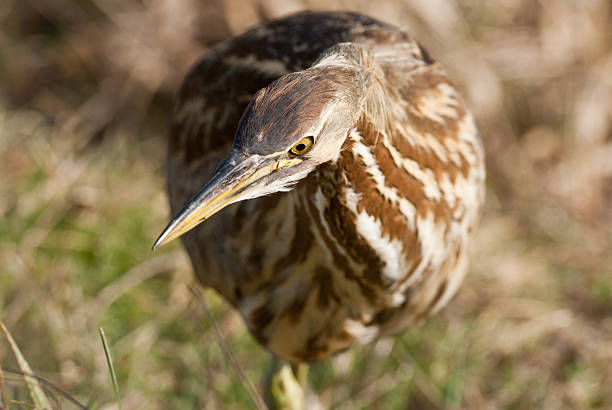
Distribution
The American Bittern is a bird that is native to North America. It primarily breeds in the northern regions of the United States and Canada. During the winter months, these birds migrate to the southern United States, Mexico, and some areas of Central America.
Breeding Range:
Canada (from British Columbia to Newfoundland)
Northern and Central US (including the Great Lakes, Midwest, and parts of New England)
Wintering Range:
Southeastern United States
Gulf Coast
Mexico
Caribbean
The American Bittern is common in many places, but its numbers are dropping in some areas. This decline is mainly because of habitat loss.
Habitat
This bird thrives in wetland environments, particularly favoring marshes, swamps, and areas dense with reeds and cattails. It shows a preference for freshwater marshes that have tall plants, providing ample cover from predators.
Typical habitat types include:
- Coastal marshes
- Inland wetlands
- Shallow lakes and ponds
- Slow-moving rivers with dense vegetation
Bitterns depend significantly on wetlands for both nesting and feeding, making them particularly vulnerable to habitat loss due to drainage and urban development.eeding. This puts them at high risk from habitat loss caused by drainage and urban growth.
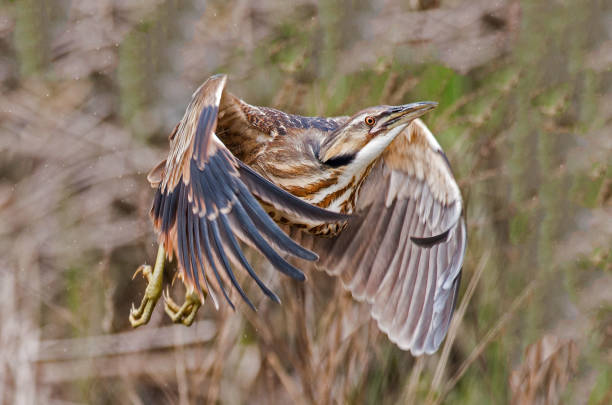
Diet
The American Bittern is a carnivorous bird that primarily feeds on aquatic and semi-aquatic creatures. As an opportunistic feeder, it consumes whatever is readily available in its environment.
Common Prey:
Fish (small freshwater species such as minnows)
Amphibians (frogs and tadpoles)
Insects (including dragonflies, beetles, and grasshoppers)
Crustaceans (like crayfish and small shrimp)
Reptiles (such as small snakes and lizards)
Bitterns are stealthy hunters. They remain motionless among the reeds before striking at their prey with their sharp beak. They are most active during the early morning and late evening, which makes them crepuscular hunters.
Behavior
The American Bittern is a reclusive bird that can be quite difficult to spot due to its remarkable camouflage and tendency to remain still. Its behavior is primarily influenced by its need for stealth and protection from predators.
Notable Behaviors:
Freeze and Camouflage: When threatened, the bittern extends its neck and sways slightly, allowing it to blend in with the surrounding reeds.
Booming Calls: During the breeding season, male bitterns produce deep, resonant calls. These sounds serve to establish their territory and attract potential mates.
Nocturnal Migration: They migrate at night, using the cover of darkness to evade predators.
Shy and Elusive: Bitterns prefer solitude. Unlike social herons and egrets, they are rarely seen in large groups.
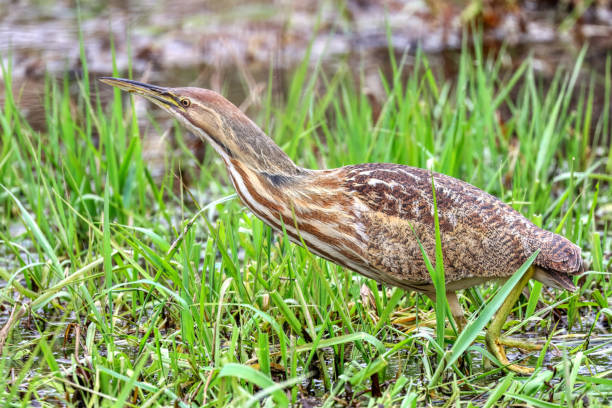
Lifespan
In the wild, American Bitterns typically have a lifespan of 8 to 10 years. However, under optimal conditions, some individuals can live up to 15 years. Their longevity is influenced by factors such as predation, the quality of their habitat, and the availability of food.
Reproduction and Lifecycle
American Bitterns exhibit either a monogamous or polygynous breeding system, with males often mating with multiple females.
Breeding Process:
Nesting: The female constructs a nest that is well-concealed among reeds and marsh vegetation, using dead plant material.
Egg Laying: A typical clutch contains 2-6 eggs, which are usually pale brown or olive in hue.
Incubation: The female takes on the responsibility of incubating the eggs alone for approximately 24-28 days.
Chicks hatch covered in down feathers. They are semi-precocial, meaning they can move around but still rely on their mother for care.
Fledging: The young birds typically leave the nest at about 4 weeks of age but may remain close to their mother for safety.
Predators
Despite their excellent camouflage, American Bitterns are vulnerable to several predators.
Common Predators:
Large Birds of Prey (such as hawks, eagles, and owls)
Mammals (including raccoons, foxes, and mink)
Snakes (which can invade nests to steal eggs and chicks)
Humans (indirectly, through habitat destruction and pollution)
Bitterns depend on their ability to blend in and remain motionless as their main strategies for evading predators.
Adaptations
The American Bittern has several unique adaptations that help it thrive in its environment.
Key Adaptations:
Vertical Camouflage: Its streaked plumage allows it to blend seamlessly into reeds and grasses.
Freeze Response: When spotted, it stretches its neck to become less visible.
Powerful Beak: This is essential for catching prey and defending against predators.
Stealthy Movement: It moves slowly and cautiously to avoid being detected while hunting.
These adaptations make the bittern one of the most elusive birds in North American wetlands.
Conservation Status
IUCN Status: Least Concern, but with declining populations
The American Bittern is not currently endangered, but its population is on the decline. This is primarily attributed to habitat loss and pollution.
Threats:
Wetland Drainage: The destruction of marshland caused by agricultural practices and urban development.
Pollution: The impact of pesticides and other pollutants on water quality.
Climate Change: Increasing temperatures and fluctuating water levels that disrupt breeding habitats.
Conservation Efforts:
Wetland Protection Programs (preserving and restoring critical habitats)
Breeding Monitoring (tracking population trends)
Legal Protections (wildlife protection laws preventing excessive habitat destruction)
Saving wetlands helps the American Bittern and other species that depend on these delicate ecosystems.
Conclusion
The American Bittern is a fascinating and elusive bird that thrives in wetland habitats. This species captivates birdwatchers and conservationists alike with its remarkable camouflage and distinctive call. However, its survival hinges on the conservation of wetland environments. By protecting these ecosystems, we ensure that future generations can appreciate the elusive and enigmatic American Bittern.
